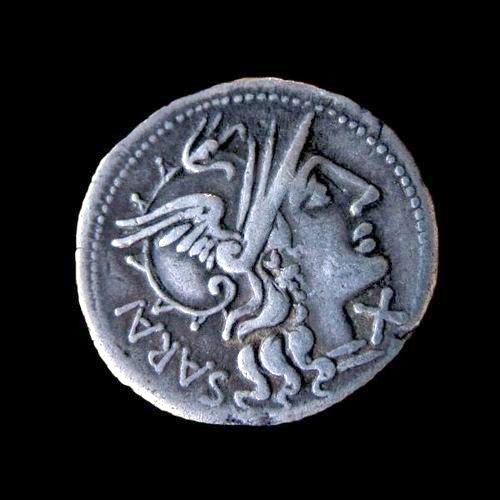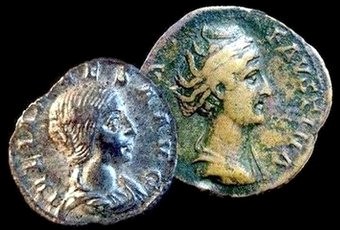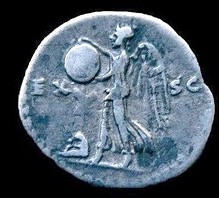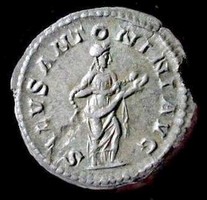

INTRODUCTION |
 |
The
original coin collection was begun early in the 1960s with a
legacy of about a hundred coins from A P Richter to the
former department of Latin at Stellenbosch University. Most of
these coins were purchased from Spink and Son in London. The late professor Frans Smuts, former head of the department of Latin, expanded the collection with funds made available by the University, thus procuring a small, but comprehensive hand-picked selection of Roman coins ranging in period from about 269 BC to AD 1041. From 1973 until 2003, the late professor Bert van Stekelenburg managed the department's numismatic collection and made a valuable contribution to our knowledge about the historical and artistic aspects of this collection. |
 |
At present the collection hosts about 180 coins - varying in condition from excellent, to extremely worn. It spans the
Republican; Imperatorial; Imperial and Byzantine periods of Roman
history and includes two Greek staters and some Roman provincial coins. The collection contains true exempla of coins
depicting various deities; ancestral heroes; a number of allegorical figures pertaining to idealised concepts; and allusions to particular events which relate to both Roman myth and Roman history. |
 |
Early Republican denarii displayed here, for
instance, often feature the helmeted head of Roma, city goddess of Rome, on the obverse,
with, on the reverse, the Dioscuri on
horseback; sometimes a chariot driven by a god. Even Hercules is shown to transgress the realm of
history on a coin struck to commemorate the military command of
Pompey the Great in Spain, whereas a commemorative
denarius pays tribute to the illustrious Roman general Gaius Marius who was famous for his
exceptional Roman military achievement. |



From the Imperatorial period (the last years of the Roman
Republic 49 - 27 BC) onwards, depictions of the Roman pantheon
decline in importance. Coinage from this period features not only
individual ancestors, but also
contemporary portraiture of prominent
military contenders. |
 |
Imperial coins in the collection display exquisite art
with the portraiture of imperial women. Striking images of these
women adorn both obverse and reverse types, and present a
showcase of a variety of women, often unconventional both in
character and countenance. This kaleidoscope of Roman imperial
women includes, among others, from the first century AD, the
notorious Poppaea, spouse of Nero;
from the early second century, the revered
Faustina Maior; from the
later half of the second century, the empress Julia Domna; from the
third century, the mysterious Otacilia
Severa; and from the early fourth century, Galeria Valeria, supreme victim of
despotism. |
The Imperial coin section features various denominations,
commencing with a number of denarii issued by Augustus, and includes inter alia a bronze as in honour of Augustus' naval
commander Agrippa; a dupondius
commemorating Germanicus' triumph in AD 17; a lepton from Judaea; an antoninianus of Herennia Etruscilla; a
quinarius of Allectus; and
concludes with a number of follises (which replaced the
radiati). Successive emperors, ever since the time of
Nero, increasingly reduced the silver content of imperial
coinage. By the reigns of, for instance,
Gallienus and Tetricus,
antoniniani resembled bronze coins with a silvery wash. Diocletian introduced the follis, a
silver-washed bronze coin, during his monetary reforms of AD 301.
The reverse of these imperial coins frequently alludes to
military matters. Depictions of, for instance, military standards
and/or various personifications (Victoria, Virtus, Genius, Fides)
pertaining to military victories are not uncommon. |
 |
 |
Military matters aside, for the purpose of propaganda, idealised
concepts such as concord; peace; and piety, for
example, are frequently shown to be of avail on the home front as
well as in the provinces; under Roman sway people joined in marriage and Roman
offspring thrived. |
 |
Next, the collection also contains a few examples of
denominationally lettered bronze coins
from the Byzantine period. Coins from this period show a
marked decline in the art of coin portraiture. Depersonalised imperial representations and Christian imagery are frequently depicted
on various follises and smaller
denominations. These denominationally lettered bronzes became
standard throughout the Byzantine world and were discontinued
only after the eighth century. Finally, a copper cavallo from the early Renaissance period completes the collection. |

| Greek | Republican | Imperatorial | Imperial | Greek Imperial | Byzantine | Renaissance |
Updated 07 / 2020 |